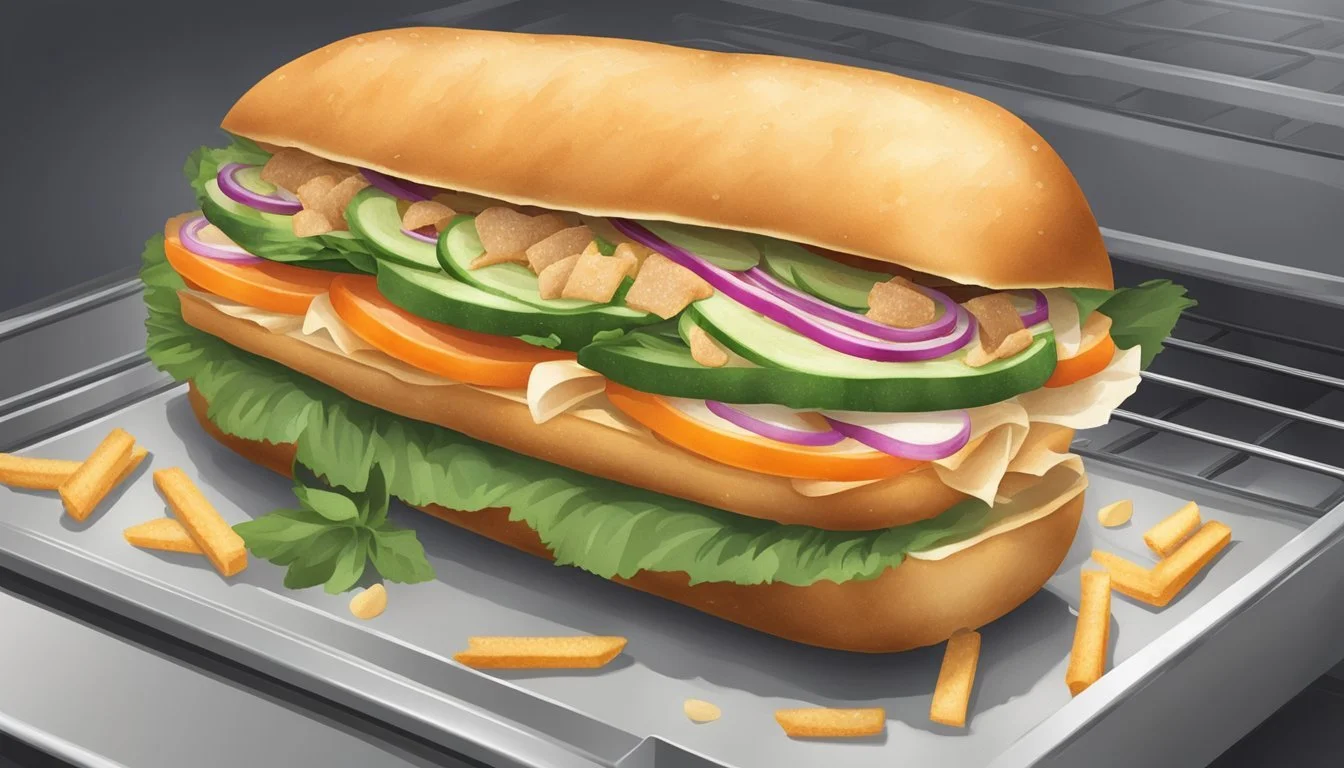Best Way to Reheat Banh Mi
Ensuring Crispy Bread & Fresh Fillings
Reheating a Banh Mi sandwich so that its bread (What wine goes well with bread?) remains crispy and fillings stay fresh is a matter of using the right technique. A quintessential Vietnamese sandwich, Banh Mi is best enjoyed with a perfect blend of warm, crispy bread and cool, fresh vegetables and herbs. The challenge of reheating Banh Mi lies in maintaining this balance without compromising the quality of any of the ingredients.
Different methods cater to various aspects of the reheating process. A toaster oven, for instance, is effective at re-crisping the bread's exterior while gently warming the interior, ensuring that meats remain succulent and bread avoids charring. However, it's crucial to remove any salad items like lettuce, cucumbers, and cilantro before heating, as these are meant to be enjoyed fresh. Covering the sandwich with foil can prevent the bread from burning and allow for an even warm-up.
When time is of the essence, the microwave might be tempting, yet caution is warranted to prevent the bread from turning hard or chewy. A trick to mitigate this is to use a damp paper towel when microwaving, which introduces moisture to keep the bread from drying out. After heating in the microwave for short intervals, one can reassemble the sandwich with its fresh components to restore the characteristic Banh Mi experience.
Understanding Banh Mi
Banh Mi sandwiches balance a unique blend of French and Vietnamese culinary traditions, providing both distinctive flavors and textures. This section delves into its origins, quintessential elements, and the sensory experience it offers.
Historical Roots
The Banh Mi sandwich is a product of French colonial influence in Vietnam. During the colonial period, the French introduced the baguette to Vietnam, which evolved into the Vietnamese baguette or "Bánh Mì". It is lighter, airier, and with a thinner crust than the traditional French baguette. Post Vietnam War, Vietnamese immigrants popularized the sandwich worldwide, merging local ingredients with French bread.
Key Components of Banh Mi
A traditional Banh Mi comprises several key components contributing to its appeal:
Bread: A Vietnamese baguette that stands out for being fluffy inside with a crispy crust.
Protein: Various savory options such as grilled pork, pâté, or tofu for vegetarians.
Vegetables: Pickled daikon and carrot add a tangy crunch, while fresh cucumber, cilantro, and sliced chili provide freshness and heat.
Sauces: Typically a combination of mayonnaise, soy sauce, and sometimes a chili sauce is used for layering flavor.
Each element plays a crucial role in creating the sandwich's unique texture and flavor.
The Texture and Flavor Profile
The texture of Banh Mi is a critical aspect of its enjoyment. The bread's crispiness juxtaposes the tender fillings, while the crunchy pickled vegetables (What wine goes well with pickled vegetables?) contrast the softness of the proteins. The flavor profile is equally complex. The Vietnamese baguette provides a neutral base that absorbs the savory meat flavors, the tang from pickled vegetables, and the aromatic herbs, resulting in a harmonious fusion that satisfies both the palate and the senses.
Storing Banh Mi Properly
Proper storage of Banh Mi is crucial to maintaining the bread's crispiness and the fillings' freshness. The key lies in controlling moisture and employing effective storage techniques.
Preventing Moisture Loss
To ensure that the bread remains crispy, one must prevent moisture loss. Storing leftover Banh Mi in a bread bag or paper bags can balance moisture levels and protect the crusty exterior from softening. The bags should be sealed adequately but not airtight, as the bread requires some airflow to maintain its texture.
Storage Techniques
For the best results, leftover Banh Mi should be stored at room temperature for short periods or in a refrigerator for extended freshness, especially when containing meats and perishable condiments. When refrigerating:
Separate the bread from the wet fillings to prevent sogginess.
Store the bread in a paper bag and the fillings in airtight containers.
Combine components only when ready to reheat and serve.
By applying these storage techniques, one can extend the shelf-life of Banh Mi while preserving its quality.
Preparation for Reheating
Reheating Banh Mi efficiently involves two crucial stages: separating the ingredients to preserve their freshness and setting up the reheating station according to the reheating method chosen. These steps ensure that the bread's crispiness and the fillings' integrity are maintained.
Ingredient Separation
Before reheating, they should carefully remove any fresh components such as lettuce, cucumber, and cilantro from the Banh Mi. This step is critical to avoid wilting or sogginess, as these items do not reheat well and are best added back after the sandwich is warmed.
Setting Up the Reheating Station
Depending on the available tools, they can choose to reheat Banh Mi using an oven, microwave, toaster oven, or air fryer.
For an oven or toaster oven:
Preheat to 350°F.
Place the Banh Mi on a baking sheet.
Cover with aluminum foil to prevent over-browning.
For a microwave:
Reheat on a microwave-safe plate.
Use a lower power setting to avoid toughening the bread.
For an air fryer:
Preheat to 350°F.
Reheat for about 5 minutes, watching to prevent excessive crisping or burning.
Reheating Methods Detailed
Choosing the right reheating method is crucial for restoring the Banh Mi's original texture and flavor, ensuring the bread remains crispy while the fillings stay fresh.
Oven Method
Oven reheating preserves the bread's crispiness effectively. Preheat the oven to 350°F and place the Banh Mi inside, minus any fresh toppings like cilantro or cucumber. Wrapping the sandwich in foil can prevent the bread from toasting too much. Reheat for about 10 minutes, checking halfway to ensure it does not dry out.
Toaster Oven and Air Fryer Method
The toaster oven works similarly to the conventional oven, reheating the Banh Mi at 350°F. It should take between 5-15 minutes, with the option to uncover it toward the end for extra crispiness. Alternatively, the air fryer provides a quicker option. Preheat to 350°F and cook for 6 minutes, flipping halfway. With its concentrated heat, the air fryer adds a desirable crunch to the crust.
Microwave Method
Using a microwave is the quickest way but may soften the bread. To counter this, wrap the Banh Mi in a damp paper towel and heat on high for 30 seconds. The steam from the towel helps to keep the bread moist on the inside and prevents it from becoming tough.
Panini Press Method
For those craving a crispy crust and warm interior, the panini press is an excellent tool. Heat the press and place the Banh Mi inside for about 3-4 minutes. This method crisps the outer layer of bread while warming the fillings uniformly, maintaining the sandwich’s overall texture.
Ensuring a Crispy Crust
A crispy crust on Banh Mi is essential for the texture and overall enjoyment of the sandwich. Achieving this requires particular reheating techniques and attention to the bread's orientation during the process.
Techniques for Crispy Bread
To maintain a crispy crust, one can utilise various reheating methods that promote even heat distribution and prevent sogginess. A common and effective method is using an oven:
Preheat the oven to 350°F (175°C).
Sprinkle the bread with a little water to reintroduce moisture.
Wrap the bread in aluminum foil with a few vents to allow steam to escape.
An alternative method involves an air fryer:
Preheat the air fryer to 350°F (175°C).
Place the Banh Mi in the fryer basket, ensuring enough space for airflow.
Cook for a total of 6 minutes, turning over midway.
Cut Side Down Approach
Reheating the Banh Mi with the cut side down can further ensure a crispy crust. This method applies when using a toaster oven or the oven. The heat directly contacts the cut side, which crisps up the texture, while protecting the fillings from direct heat. Here's how to do it:
Place the Banh Mi cut side down on a baking sheet.
Heat for a few minutes until the desired crispiness is achieved.
Remember to remove any sensitive fillings such as fresh vegetables or sauces before reheating to prevent them from becoming wilted or soggy.
Maintaining Fresh Fillings
When reheating Banh Mi, one needs to preserve the integrity of the sandwich's fresh elements to ensure optimal flavor. Careful handling of vegetables and a tailored approach to proteins are crucial.
Handling Vegetables and Herbs
Vegetables and herbs, such as cilantro and pickled vegetables, should be removed before reheating to maintain their crispness and vibrant flavors. Here's a step-by-step guide to keeping them fresh:
Remove all fresh vegetables and herbs.
Store them in a cool place.
Reassemble them in the Banh Mi after reheating.
Pickled vegetables, a key component, lend a tangy crunch. They are best when kept in their pickling liquid until serving.
Reheating Meats And Proteins
The proteins in a Banh Mi, like pork belly (What wine goes well with pork belly?), tofu, or eggs, should be reheated separate from the bread to avoid sogginess while ensuring they are warmed thoroughly. Consider the following techniques:
Pork Belly: Heat gently in a pan to render remaining fat and warm through without drying out.
Tofu: Warm in a non-stick pan with minimal oil to maintain texture.
Eggs: If included as a fried component, reheat on a pan on low heat to maintain moisture.
The goal is to reheat just enough to make the proteins palatable without compromising their textures and flavors.
Condiments and Toppings
Reviving a Banh Mi to its original splendor involves more than simply reheating; the proper integration of condiments and fresh toppings is crucial. This ensures the balance of flavors and textures that make a Banh Mi distinctive.
Reintegrating Mayonnaise and Pâté
After reheating the bread and protein components of a Banh Mi, mayonnaise and pâté should be reapplied if they've been removed prior to reheating. These condiments should be spread with precision to prevent sogginess:
Mayonnaise: A thin, even spread on one side of the bread maintains moisture without overwhelming other flavors.
Pâté: A complementary layer on the opposite side enriches the sandwich with its savory, umami depth.
A balance of these condiments allows for a seamless melding of tastes once the Banh Mi is fully assembled.
Adding Fresh Salad Items
Incorporating fresh salad items back into the Banh Mi brings back the essential crispness and brightness:
Vegetables: Tuck in slices of cucumber or pickled carrots and daikon, ensuring each bite contains a bit of their refreshing crunch.
Herbs: Sprinkle fresh cilantro leaves on top to introduce a burst of herby freshness that is signature to the Banh Mi experience.
Seasoning: Before sealing the sandwich, a pinch of salt and sugar can be sprinkled over the vegetables to enhance their natural flavors.
By restoring these essential fresh elements, the Banh Mi is rejuvenated, providing the eater with an experience akin to its first assembly.
Final Touches and Serving
Once a Banh Mi has been carefully reheated to maintain its distinctive crispy texture, the final touches are critical to preserving the freshness and authenticity of this iconic sandwich.
Assembling the Reheated Banh Mi
After reheating the Banh Mi, the sandwich should be assembled while the bread is still warm to ensure the texture remains optimal. Familiar ingredients in a traditional Banh Mi include grilled meats, pickled vegetables, and fresh herbs. One should carefully add back any salad items—like lettuce, cucumber, and cilantro—that were removed prior to reheating. This helps to maintain the fresh crunch and vibrant flavors that are hallmarks of Vietnamese cuisine.
Fresh Ingredients to Add Post-Reheating:
Lettuce
Cucumber
Cilantro
Fresh chili (optional)
Serving Suggestions and Tips
Banh Mi is best served immediately after it has been reheated and assembled to ensure the bread's crispiness and the fillings' freshness. For an added zing, drizzle a small amount of chili sauce over the fillings or serve it on the side. Keeping the sandwich wrapped in paper for a minute allows the steam to slightly soften the crust, making it less crumbly and easier to bite into.
Condiments to Enhance Flavor:
Chili sauce
Mayonnaise (authentic or with a twist, such as spicy mayo)
Pâté (for a richer flavor profile)
Serving Tips:
Serve immediately after assembly
Wrap in paper for a minute before serving
Offer extra condiments on the side
Following these tips and tricks ensures that the reheated Banh Mi retains the qualities associated with Vietnamese recipes, emphasizing a balance of textures and freshness in every bite.
Making Banh Mi from Scratch
Crafting Banh Mi from scratch involves preparing a traditional Vietnamese baguette which is the foundation of the dish, complemented with savory fillings. A perfect Banh Mi embodies the blend of French and Vietnamese cuisine, where the baguette's crispy crust and airy interior meet fresh and vibrant ingredients.
Traditional Banh Mi Recipe
The recipe for traditional Banh Mi starts with a selection of proteins such as pork, chicken, or tofu, often marinated in a mixture of soy sauce, lime juice, and spices. Vegetables play a crucial role, including pickled carrots, daikon radish, fresh cucumbers, and slices of spicy jalapeños. To incorporate richness, pâté or mayonnaise, and sometimes a sprinkle of soy sauce, are spread onto the baguette.
Ingredients for Marinade and Fillings:
Proteins (pork, chicken, or tofu)
Soy sauce
Lime juice
Garlic
Sugar
Table salt
Carrots (julienned)
Daikon radish (julienned)
Cucumber (sliced)
Jalapeños (sliced)
Pâté or Mayonnaise
Preparation Steps:
Marinate the protein with soy sauce, lime juice, chopped garlic, sugar, and salt, then grill or bake until cooked.
Prepare the pickled vegetables by combining julienned carrots and daikon with a mixture of sugar, salt, and vinegar.
Slice the fresh vegetables and set aside.
If using pâté, spread a thin layer on one side of the baguette.
Creating the Perfect Vietnamese Baguette
A Vietnamese baguette differs slightly from its French cousin, being airier and with a thinner crust. The secret lies in the dough, which often incorporates a bit of rice flour into the traditional bread flour base. This creates a lighter texture and the signature crispiness. The bread should have a golden crust with an audible crunch, achieved through proper kneading, rising, and baking techniques.
Ingredients for Baguette Dough:
Bread flour
Rice flour (optional for a lighter texture)
Instant yeast
Granulated sugar
Table salt
Warm water
Butter (room temperature, for brushing)
Egg (for egg wash)
Bread Making Steps:
Mix bread flour, a touch of rice flour if using, yeast, sugar, and salt. Add warm water gradually until the dough forms.
Knead the dough until it's smooth and elastic, promoting gluten development for texture.
Allow the dough to rise in a warm place until it doubles in size.
Divide the dough and shape into baguette loaves, using a bread lame or sharp knife to make shallow diagonal slashes on the surface.
Apply an egg wash for a glossy finish and bake on a baguette pan in a preheated oven until golden brown. Brush with melted butter for extra flavor and a shiny crust.
Baking Tools:
Measuring cup
Thermometer
Mixing bowl
Bread lame or sharp knife
Baguette pan
Following these guidelines ensures the Banh Mi boasts a crisp and light baguette crust, while the fillings provide a flavorful and fresh contrast, essential for this beloved Vietnamese sandwich.







